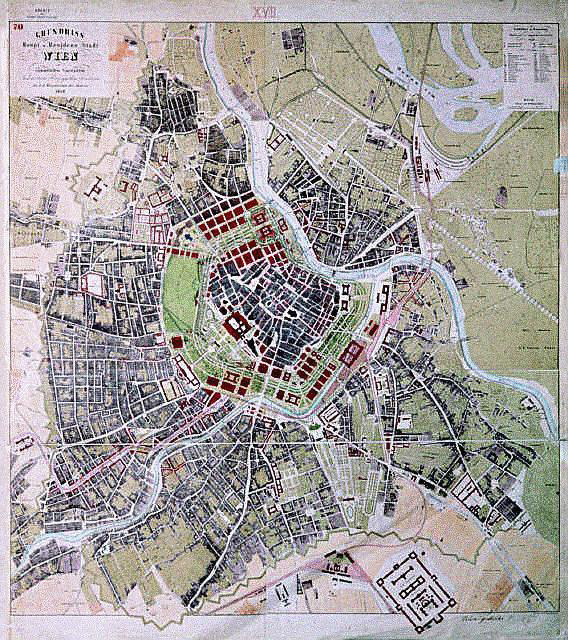The "Ringstrasse"-period - History of Vienna
It was only the revolutionary year of 1848, with its, admittedly, temporary success in striving for a constitution, that opened up a new era, at least as far as the abolition of the existing landownership pattern at the time is concerned. The landlords' administrative and judicial rights were now transferred to government institutions. For Vienna itself, all obstacles thrown in the way by the conflicts arising between the landowners were eliminated once and for all. In 1850 the city launched its first expansion drive by incorporating the suburban zone within the Linienwall and organising it into city districts.
With an entirely new territorial context, the question of the continued existence of the fortification walls at long last gained more topical interest. For some years, the military circles were able to hold their own in maintaining their demand for these massive demarcations, making a case for the defences, most of all, in the light of the revolutionary developments of those years. It was not until 1857 that Emperor Francis Joseph decided to have the defences razed. The now available building land - and prime building land it was too - was immediately incorporated into all planning programmes. The land included not only the walls themselves but the entire belt of old military fortifications, hence a wide ring around the inner city.
To this day, the name of Vienna is associated on the international level with the term "Ringstrasse", the splendid boulevard with its many stately public buildings, which was built in lieu of the fortifications at the time. Designed in the new style of the day, historicism, new government departments, museums, the court (now state) opera and the parliament building (which is still in use today), the new university and many other structures went up. Well into the 1870s a fairly large area along Ringstrasse continued to be used for military purposes, as a parade and exercising ground. It was only at a relatively late point in time that the new City Hall was built in this location in neo-Gothic style. The City Hall has continued to be the seat of the city government to this day.
Developing the infrastructure
The City Council, the city's legislature, was elected following the constitutional amendments of 1848. But it was not until 1907 for men and 1919 for women that the considerably restricted right to vote was expanded to the meanwhile accustomed scope and consolidation. With the new territorial context laid down in 1850, the city government, which had also been given a new constitution, was able, over the next decades, to embark upon a series of infrastructural programmes which were long overdue. At first, the city used the services of private enterprises for some considerable time. At the turn of the century, however, it launched a massive attempt to provide communal services and utilities itself. Thus, for instance, gas supplies were controlled by the Vienna Imperial Gas Association. This obviously made this new source of energy subject to marked economic restrictions. As early as the 1850s gas was used for improving street lighting. It was not until around 1900 that it was gradually superseded by a new source of energy, electricity.
Regulating the Danube
The one construction project that had perhaps the most long-lasting and profound impact on the cityscape was doubtless the regulation of the Danube between 1869 and 1875. The river had formed an extensive criss-cross of branches and backwaters in the Vienna area. Crossing the river was difficult before a system of connecting bridges was established in the late Middle Ages (1439). Ships had access to the city via an arm skirting the inner city in the north. Now an entirely new river bed was excavated, with the former inner city branch forking off as the regulated "Danube Canal". Henceforth navigation was on the main river, bypassing the city proper, which subsequently gave growing economic significance to the area between the Danube Canal and the main river.
Drinking water
The hopelessly inadequate drinking water supply of the hugely increased urban population was also redesigned from scratch during the second half of the 19th century. The city commissioned the construction of the First Vienna Spring Water Main, to be followed, in the early 20th century, by a Second Vienna Spring Water Main). The system brought fresh spring water from a distance of more than 65 miles from the Alpine foothills south of Vienna, on the borderline between Lower Austria and Styria. It constituted a significant contribution in the interest of public health. And public health continued to be in dire need of improvement: the social situation in the wake of continued industrialisation and highly inadequate working conditions further contributed to the misery, so much so that pulmonary tuberculosis acquired the dubious distinction of being called "morbus Viennensis".
City of Vienna | Municipal and provincial archives of Vienna
Contact form

